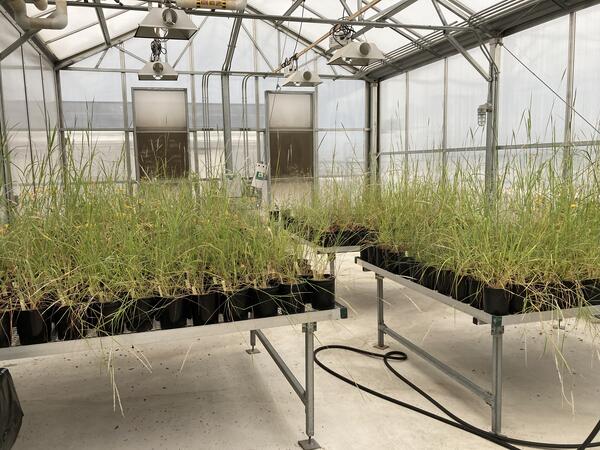Five tule white-fronted geese take off from Summer Lake Wildlife Area, the primary stopover site for this species on its fall migration.
Images
See our science through the images below.

Five tule white-fronted geese take off from Summer Lake Wildlife Area, the primary stopover site for this species on its fall migration.
Cactus blossom in the southeast Arizona grasslands, looking into Mexico.
Cactus blossom in the southeast Arizona grasslands, looking into Mexico.
Cactus blossom in the southeast Arizona grasslands, looking into Mexico.
Cactus blossom in the southeast Arizona grasslands, looking into Mexico.
I Am An...Ecotoxicologist
I Am An...Ecotoxicologist
I Am A...Climate Modeler coloring page.

Another Columbia spotted frog (Rana luteiventris) collected for methylmercury sampling in Montana.
linkA Columbia spotted frog (Rana luteiventris) collected for methylmercury sampling in Montana.
Another Columbia spotted frog (Rana luteiventris) collected for methylmercury sampling in Montana.
linkA Columbia spotted frog (Rana luteiventris) collected for methylmercury sampling in Montana.

RestoreNet is partnering with the Gornish lab at the University of Arizona to better understand how a plant’s source location (provenance) influences its performance in a restoration setting. This greenhouse experiment will be conducted by PhD student, Sierra Lauman.
RestoreNet is partnering with the Gornish lab at the University of Arizona to better understand how a plant’s source location (provenance) influences its performance in a restoration setting. This greenhouse experiment will be conducted by PhD student, Sierra Lauman.
Small stream running through an agricultural area in Iowa with crops surrounding it.
Small stream running through an agricultural area in Iowa with crops surrounding it.

Hawkmoth flying near milkweed plant in North Dakota. Northern Prairie Wildlife Research Center is monitoring milkweed populations across the Central United States.
Hawkmoth flying near milkweed plant in North Dakota. Northern Prairie Wildlife Research Center is monitoring milkweed populations across the Central United States.
Early Life Stage (ELS) tests are used as an alternative to traditional whole-animal testing methods for evaluating toxicity of chemicals. ELS for birds involve injection into the air cell of fertile eggs early in development and artificial incubation for several days at which point tissues are sampled for analysis.
Early Life Stage (ELS) tests are used as an alternative to traditional whole-animal testing methods for evaluating toxicity of chemicals. ELS for birds involve injection into the air cell of fertile eggs early in development and artificial incubation for several days at which point tissues are sampled for analysis.
Bumblebee feeding on Phacelia flower found in an established Pollinator Plot at Northern Prairie Wildlife Research Center, Jamestown, North Dakota.
Bumblebee feeding on Phacelia flower found in an established Pollinator Plot at Northern Prairie Wildlife Research Center, Jamestown, North Dakota.
Once thought to be extinct, the Pacific pocket mouse (Perognathus longimembris pacificus) was rediscovered in 1993 and is currently found at three population sites along the southern California coast.
Once thought to be extinct, the Pacific pocket mouse (Perognathus longimembris pacificus) was rediscovered in 1993 and is currently found at three population sites along the southern California coast.

Orange and black excluder device (left) will contain minerals, but intended to allow livestock access while excluding wildlife. Mineral block to the right of excluder device.
Orange and black excluder device (left) will contain minerals, but intended to allow livestock access while excluding wildlife. Mineral block to the right of excluder device.

The United States is developing renewable energy resources, especially solar, at a rapid rate.
The United States is developing renewable energy resources, especially solar, at a rapid rate.
The light-footed Ridgway’s rail, a handsome but secretive waterbird that lives on tidal marshland fragments in southern California from Santa Barbara County south to Baja California, Mexico.
USGS is gathering and analyzing DNA from blood samples throughout the subspecies’ range to document the light-footed Ridgway’s rail’s genetic health.
The light-footed Ridgway’s rail, a handsome but secretive waterbird that lives on tidal marshland fragments in southern California from Santa Barbara County south to Baja California, Mexico.
USGS is gathering and analyzing DNA from blood samples throughout the subspecies’ range to document the light-footed Ridgway’s rail’s genetic health.
Light trails of LED-tagged sea lampreys, part of a study of sea lamprey sex pheromone antagonists, altered pheromone cocktails that can disrupt spawning behavior.
Light trails of LED-tagged sea lampreys, part of a study of sea lamprey sex pheromone antagonists, altered pheromone cocktails that can disrupt spawning behavior.
A light trail of an LED-tagged sea lamprey, part of a study of sea lamprey sex pheromone antagonists, altered pheromone cocktails that can disrupt spawning behavior.
A light trail of an LED-tagged sea lamprey, part of a study of sea lamprey sex pheromone antagonists, altered pheromone cocktails that can disrupt spawning behavior.
Sea lampreys spawning in a stream during a study that tested how sea lamprey sex pheromone antagonists influenced spawning behavior.
Sea lampreys spawning in a stream during a study that tested how sea lamprey sex pheromone antagonists influenced spawning behavior.
Spawning sea lampreys tagged for a study of sea lamprey sex pheromone antagonists.
Spawning sea lampreys tagged for a study of sea lamprey sex pheromone antagonists.
Sea lamprey spawning during a study of sea lamprey sex pheromone antagonists, altered pheromone cocktails that can disrupt spawning behavior.
Sea lamprey spawning during a study of sea lamprey sex pheromone antagonists, altered pheromone cocktails that can disrupt spawning behavior.
A sea lamprey tagged with a red LED light as part of a study of sex pheromone antagonists, altered sex pheromone compounds that can interfere with sea lamprey spawning.
A sea lamprey tagged with a red LED light as part of a study of sex pheromone antagonists, altered sex pheromone compounds that can interfere with sea lamprey spawning.















